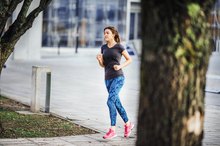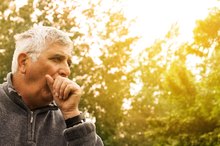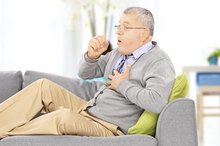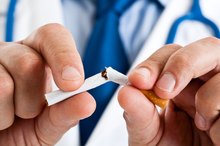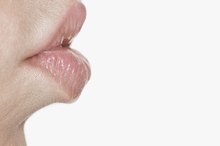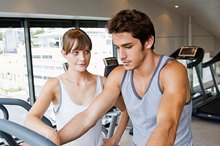Long-Term Effects of Exercise on the Respiratory System
你的呼吸系统控制你的呼吸d begins when you draw in air through your nose or mouth. The air travels through your windpipe into both of your lungs, where small air sacs capture oxygen and distribute it in your bloodstream through small blood vessels called capillaries. Your diaphragm is the muscle the controls respiration and contracts when you inhale. Your diaphragm then relaxes, collapses your chest and forces out carbon dioxide when you exhale.
Alveoli
Capillaries surround small air sacs, called alveoli, inside your lungs that capture the oxygen you breathe in. Your lungs adapt to regular exercise by activating more alveoli. More alveoli can supply more oxygen to working muscles and tissues throughout your body. Pneumonia occurs when fluids in your lung prevent alveoli from exchanging gases. Having more alveoli can suppress the effects of pneumonia by reducing the proportion of alveoli that are affected by this disease. Emphysema occurs when alveolar walls break down and gradually reduce the exchange of oxygen and carbon dioxide in your lungs. Regular exercises may help slow the progression of emphysema by increasing the number of gas-exchanging alveoli.
- Capillaries surround small air sacs, called alveoli, inside your lungs that capture the oxygen you breathe in.
- More alveoli can supply more oxygen to working muscles and tissues throughout your body.
Mucus
How Does Running Increase Lung Capacity?
Learn More
Exercise exposes your lungs to stronger rushes of airflow. Aerobic exercise in particular exposes your lungs to strong and constant rushes of air. This activity helps clear mucus in your lungs. Mucus build-up can diminish your lung capacity and lead to bacterial infections. According to a 1997 “European Respiratory Journal” article by the University of Ulsan’s Wong Don Kim, excessive mucus in your lungs is associated with higher mortality, may obstruct airflow and increases your risk of infections. Regular exercise can help offset these conditions by preventing mucus from building up in your lungs.
- Exercise exposes your lungs to stronger rushes of airflow.
- Aerobic exercise in particular exposes your lungs to strong and constant rushes of air.
Capillaries
Capillaries are the smallest blood vessels in your body. Oxygen seeps out of thin capillary walls as carbon dioxide seeps in during respiration. Exercise stimulates vasodilation, which increases the diameter of blood vessels in your body, including the capillaries. Your body adapts to long-term exercise by increasing the size and number of capillaries, including alveolar capillaries. This adaptation makes the exchange of carbon dioxide and oxygen more efficient.
- Capillaries are the smallest blood vessels in your body.
- Your body adapts to long-term exercise by increasing the size and number of capillaries, including alveolar capillaries.
Muscles
What Is Basilar Consolidation?
Learn More
The skeletal muscles that control respiration include your diaphragm and intercostals. Your diaphragm is a broad band of muscle that sits under your lungs and forms the base of a region known as the thoracic cavity by attaching to the lower parts of your ribs, sternum and spine. The intercostals form the muscle tissue in between individual ribs. The long-term effect of exercise is to build the endurance of these respiratory muscles, allowing deeper, fuller and more efficient breaths.
- The skeletal muscles that control respiration include your diaphragm and intercostals.
- Your diaphragm is a broad band of muscle that sits under your lungs and forms the base of a region known as the thoracic cavity by attaching to the lower parts of your ribs, sternum and spine.
Related Articles
References
- National Federation of Professional Trainers: Personal Fitness Trainer Manual
- Planet Olive: Physical Exercise
- Franklin Institute: Capillaries
- Teach PE: Long-Term Effects of Exercise
- Teach PE: Respiratory System
- Meddean: External Intercostals
- Knudsen, L., and M. Ochs. The Micromechanics of Lung Alveoli: Structure and Function of Surfactant and Tissue Components. Histochemistry and Cell Biology. 2018. 150(6):661-676. doi:10.1007/s00418-018-1747-9
- Hsia C, Hyde D, Weibel E. Lung Structure and the Intrinsic Challenges of Gas Exchange. Comprehensive Physiology. 2016. 6(2):827-895. doi:10.1002/cphy.c150028
- 克努森L, Ochs m .肺alve的微观力学oli: structure and function of surfactant and tissue components. Histochemistry and Cell Biology. 2018. 150(6):661-676. doi:10.1007/s00418-018-1747-9
- Trapnell BC, Nakata K, Bonella F, et al. Pulmonary alveolar proteinosis. Nature Reviews. Disease Primers. 2019. 5(1):16. doi:10.1038/s41572-019-0066-3
- Kasper, Dennis L.., Anthony S. Fauci, and Stephen L.. Hauser. Harrison's Principles of Internal Medicine. New York: Mc Graw Hill education, 2015. Print.
Resources
Writer Bio
Miguel Cavazos is a photographer and fitness trainer in Los Angeles who began writing in 2006. He has contributed health, fitness and nutrition articles to various online publications, previously editing stand-up comedy and writing script coverage as a celebrity assistant. Cavazos holds a Bachelor of Arts in philosophy and political science from Texas Christian University.


